Observation and Measurement of Connectors
Connectors are very common in electrical devices and come in a wide variety of types. This section introduces typical problems seen in connectors, including corrosion, oxidation, wear, foreign particle adhesion, solder defects, whiskering; all of which can cause failure.
This section also includes application examples using KEYENCE's latest 4K digital microscope to overcome common problems associated with inspecting connectors.
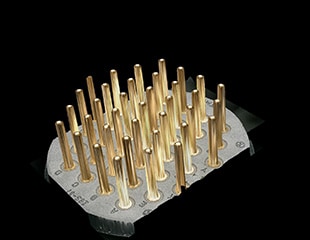
- Diversified Connector Types and the Importance of Quality
- Typical Connector Problems, Causes, and Solutions
- Problems in Connector Observation and Evaluation and Application Examples of the 4K Digital Microscope
- High-resolution observation of industrial connector terminals
- Evaluation of connector pin shapes
- Observation of deep connectors and terminals
- Observation of plated crimping terminals and connector pins
- Evaluation of cross-sectioned connectors
- Observation of dents on plated surfaces
- Quantitative evaluation of solder defects on connector electrodes
- The Optimal Microscope for Observation, Measurement, and Evaluation of Connectors
Diversified Connector Types and the Importance of Quality
The number of connectors and different types of connectors has increased rapidly in response to the expanded use of digital devices.
Common connector types include USB, RJ-45, LC/SC, XLR, RCA, and HDMI; all of which require rigorous inspection to ensure reliable performance.
In addition to connectors for consumer use, many general-purpose and special-purpose connectors are used in various industrial fields. Contact failures and defective insulation may not only lead to complaints from consumers, but may also prevent professionals from completing their tasks.
Connectors are also used in special electrical parts, such as wiring harnesses in automobiles where important components are increasingly controlled electronically. Any defects and corrosion of such connectors can lead to accidents. This is why high quality and reliability are required for connector products.
Typical Connector Problems, Causes, and Solutions
The following are typical connector problems that can cause contact failures, electrical continuity failures, or defective insulation that can impair quality and performance.
- Corrosion/Oxidation
- Phenomenon: This problem occurs when nickel, copper, or other metal in the base metal corrodes and separates to form a deposit on the surface.
Possible causes: High temperature, high humidity, and corrosive gases
Action: Plate the connectors with gold or apply a corrosion and oxidation inhibitor.
- Wear
- Phenomenon: This problem occurs when vibration or impact causes contacting parts to slide and subsequently wear down.
Possible causes: Vibration, impact, very frequent insertion and removal
Action: Use a connector with high contact pressure and wide contact surface.
- Adhesion of Foreign Particles
- Phenomenon: This problem occurs when foreign particles stick to the connector and obstruct electrical conduction.
Possible causes: Intrusion of gas or fine particles into the connector
Action: Increase the degree of sealing and airtightness.
- Solder Defects
- Phenomenon: This generic term refers to defective insulation or defective electrical continuity caused by improper application of solder.
Possible causes: Solder fractures or cracks, solder balls, solder bridges, and other defects
Action: Review the heating temperature and time for the solder.
- Whiskering
- Phenomenon: This problem occurs when tin in the plating crystallises in the form of whiskers and grows. Whiskering causes insulation to break down and leads to a short circuit.
Possible causes: Metal internal stress
Action: Plate the connectors with gold.
- Migration
- Phenomenon: This problem occurs from the gradual movement of the ions in a conductor, causing dielectric breakdown.
Possible causes: High temperature, high humidity
Action: Apply a damp-proof coating such as fluorine film.
Problems in Connector Observation and Evaluation and Application Examples of the 4K Digital Microscope
In recent years, connectors have become smaller and more complex. Some connectors are very popular for many years, and then become obsolete nearly overnight due a single product or family of products changing their connector type. To respond to such rapid changes in demand, the connector industry relies on fast R&D cycles and quick quality control inspections.
Microscopes are typically used for connector inspections and defect analysis. Conventional microscopes, however, typically have the following problems:
- The image only focuses on a part of the target due to the connectors being three dimensional.
- Reflections from metal portions can interfere with observation.
- Stereoscopic microscopes only provide planar visual inspection, making it difficult to identify causes of problems.
- Separate measuring instruments are needed as the microscopes can only be used for observation
KEYENCE has repeatedly improved its digital microscopes over the past 20 years using feedback from our customers.
The result of this process is the VHX Series high-definition 4K Digital Microscope, which not only overcomes conventional problems, but also provides additional features and functions for improving workflow efficiency.
This section introduces the latest examples of connector observation, measurement, and analysis using the VHX Series.
High-resolution observation of industrial connector terminals
Due to the limitations of the depth of field of conventional microscopes, it was only possible to bring a part of a three-dimensional target into focus at a time. At the same time, it sometimes was difficult to observe microscopic defects due to insufficient resolution.
The VHX Series 4K Digital Microscope uses an HR lens that supports 4K images, a depth of field that is approximately 20 times deeper than that of conventional microscopes, and a high-resolution and low-noise 4K CMOS.
This allows users to capture fully-focused, high-resolution images on three-dimensional connector terminals. Details that previously could not be seen can be easily observed and analysed.
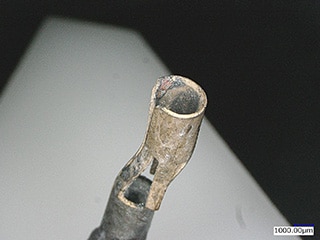
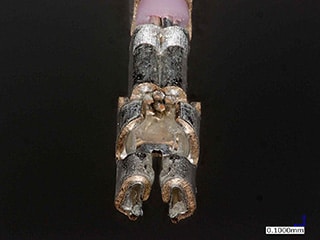
Evaluation of connector pin shapes
While capturing fully-focused images, the VHX Series is also capturing 3D height information that can be used to evaluate the shape of the connector pins.
The 3D image is displayed with a highly accurate height colour map, which allows users to easily see if the height of the pins is consistent.
With the VHX Series, a single unit is all that is needed to completely inspect connectors. Visual observation, 2D/3D measurements, and report creation can all be quickly performed, greatly improving workflow efficiency and reducing working hours.
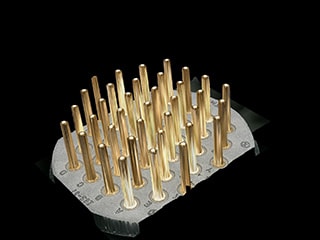
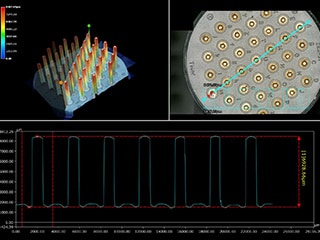
Observation of deep connectors and terminals
Some industrial connectors in a long housing or shield have pins and terminals in the recessed areas. Conventional microscopes cannot bring the entire target into focus, making it impossible to inspect the entire part.
The VHX Series 4K Digital Microscope has a 20x larger depth of field than conventional microscopes and the ability to perform depth composition to bring the entire target into focus. This improves the efficiency of the inspection procedure and eliminates blind spots.
Furthermore, using the free-angle observation system enables tilted observation from any angle without the need to reset the target on the stage. Even long connectors can be observed quickly at the optimal angle.
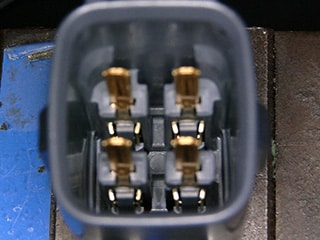
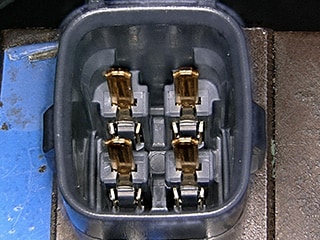
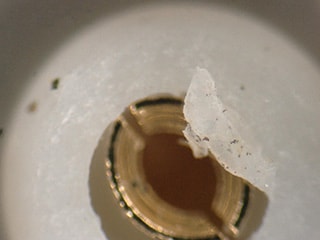
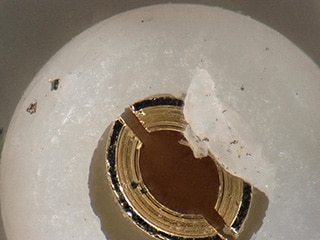
Observation of plated crimping terminals and connector pins
Some connector pins and terminals are gold-plated to prevent defective electrical continuity and defective insulation caused by corrosion, oxidation, or whiskering. Reflective shiny plated surfaces, however, often have glare, making it difficult to observe and evaluate the surface conditions correctly.
The VHX Series 4K Digital Microscope has glare removal and ring-reflection removal functions. This enables users to clearly observe the surface conditions of plated connector pins, even when they are highly reflective and have complex geometries.
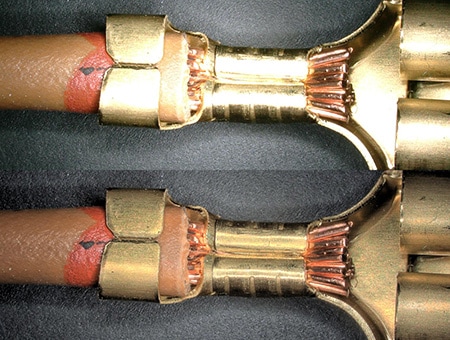
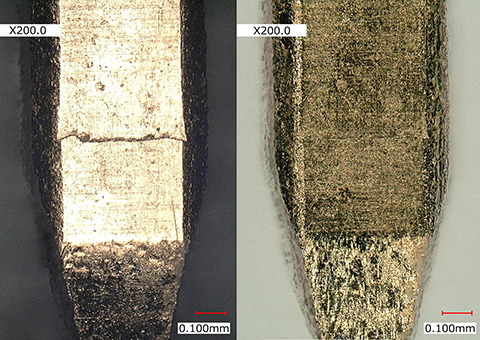
Evaluation of cross-sectioned connectors
The VHX Series 4K Digital Microscope creates a high-resolution image of up to 50,000 x 50,000 pixels through high-speed image stitching. Just pushing the image stitching button will easily and quickly stitch together high-magnification images automatically with no misalignment.
Cross-sectioned samples with surface irregularities can be quickly stitched at low-magnification, then high-magnification can be used to inspect small details while still tracking what portion of the target is being viewed.
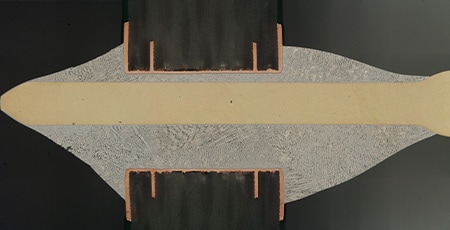
Observation of dents on plated surfaces
A connector is comprised of various materials such as metal and resin. It is difficult to determine the lighting conditions for an area that includes highly reflective portions, such as plated surfaces and copper foil tapes, because glare from such shiny surfaces interferes with the observation of dents and other defects.
The VHX Series 4K Digital Microscope has a multi-lighting function, which automatically captures the data of multiple images under omnidirectional lighting at the push of a button. Then, the image most suitable for observation can be selected from among the captured images, which significantly improves work efficiency and observation accuracy. Even dents, for which it was difficult to determine the best lighting conditions, can now be easily observed.
Furthermore, image data with different lighting conditions is automatically saved and can be recalled when needed, eliminating the need to reimage the sample at a later date.
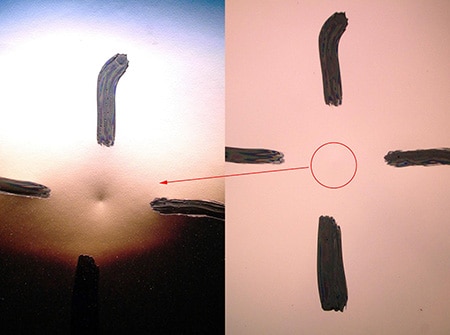
Quantitative evaluation of solder defects on connector electrodes
Solder defects, such as pits and cracks, on connector electrodes can not only cause defective electrical continuity, but also increase the resistance at the defective points. The increased resistance can then cause heating and ignition at the defective points. Conventional microscopes, however, cannot quantitatively evaluate the defects due to glare from the solder.
The VHX Series 4K Digital Microscope has glare removal and ring-reflection removal functions, thus enabling observation of defective areas with clear images having no glare. The captured observation images can also be used for high-accuracy 3D shape measurement and profile measurement in a specified area. Such measurements enable quantitative measurement and evaluation of defective areas with higher efficiency.
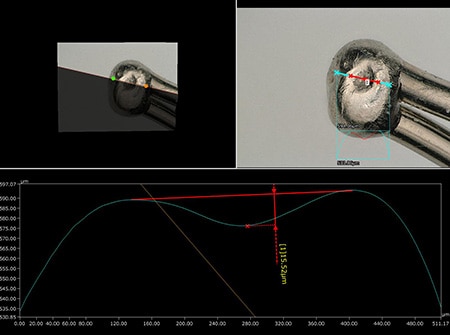
The Optimal Microscope for Observation, Measurement, and Evaluation of Connectors
The VHX Series 4K Digital Microscope greatly differs from conventional optical microscopes in that it can clearly observe 3D shapes—such as connectors and their component parts and internal structures—and accurately measure them with ease and speed.
Unlike scanning electron microscopes, the VHX Series does not require time-consuming sample preparation to observe and analyse surfaces.
The VHX Series is also equipped with many other functions in addition to those introduced here. For additional product info or inquiries, click the buttons below.


